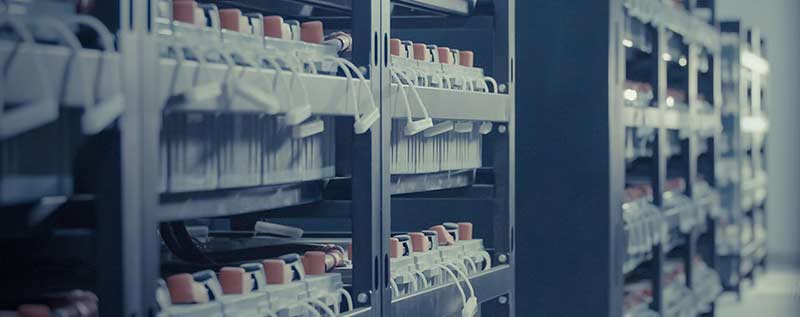Deep-cycle solar batteries must be protected from the elements. If freezing temperatures are expected, the batteries can be buried below the frost line in a water-tight enclosure or in a building where the temperature will remain above freezing. If the batteries are buried, a well-drained location should be selected and a drain hole provided in the battery enclosure. Batteries should not be set directly on concrete surfaces as self discharge will be increased, particularly if the surface gets damp. Adequate venting must be provided to minimize explosion hazard if open-cell batteries are used. Consider using battery fan which will not ignite the hydrogen and oxygen gas that is naturally produced during the charging process. Any battery should be stored in a location where access is limited to knowledgeable personnel. Never allow unsupervised children or pets near batteries.
How to Store Lithium Solar Batteries
Lithium deep-cycle batteries can be stored and used indoors, providing an easy way to give them shelter and insulation. If using outside where freezing temperatures are a possibility, always remember that lithium batteries should never be charged in temperatures below freezing (32°F or 0°C) – even though they be safely discharged in temps down to 0°F (-18°C).
Most lithium solar batteries available today feature some kind of onboard BMS (battery management system) that can be used to activate an external heating source in freezing weather. Some of the more advanced lithium solar batteries – like the KiloVault CHLX cold-rated lithium batteries – actually have an internal heating element managed by their BMS, so thermal regulation is automated and you don’t need to provide an external heat source.
How to Store Flooded Lead Acid Solar Batteries
Flooded lead acid solar batteries can charge at lower temps than lithium-ion batteries (as low as -4°F or -20°C), but they require more attention and care than lithium batteries. Flooded lead acid batteries must not be used inside your house (due to the release of highly explosive hydrogen gas while in use), so instead they should be kept in a vented enclosure or battery box.
This enclosure/box can be inside an insulated shed or garage for warmth if there is adequate ventilation for the off-gassing. If the enclosure/box will be outside, then it will need to be insulated if temperatures approaching 0°F are a possibility at any point. Simple rigid foam insulation from a hardware store is adequate (flooded batteries generate some heat while charging, so insulation warms up the enclosure). When choosing insulation, make sure you get the right R-value (determined by the geographic location on the enclosure) and be sure to use insulation rated for below-grade use (because of its moisture resistance).
How to Store AGM/Sealed Lead Acid Solar Batteries
Like lithium solar batteries, sealed lead acid batteries like AGMs are safe to use indoors. Sealed cells also freeze at lower temperatures than flooded cells do – but if they’ll be exposed to temperatures lower than the minimum temperatures recommended by the manufacturers, you can follow the same techniques listed above for other battery types to keep your sealed-cell batteries warm enough for safe storage and use (insulated enclosure and a BMS/heater).



